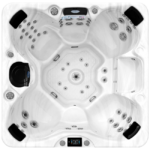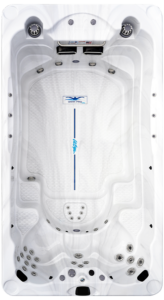comparison
When deciding on what type of in ground pool to install, it is essential to do the proper research before buying. The decision between vinyl, fiberglass or gunite (otherwise known as plaster) for in ground pool selection generally comes to down to factors such as installation costs, how long it will take to install, overall maintenance, and appearance. Everyone’s tastes are different but when it comes to cost and upkeep, vinyl is the clear winner. There’s no reason to be afraid of vinyl as this is not a new technology. Vinyl liner pools may be new to you, but they are certainly not new to Secard Pools.
Plaster pools do offer the most options in terms of design. Depending on your budget, you can design a plaster pool that is one of the most visually-pleasing spaces in your backyard, including those that feature grottos, rock slides, a waterfall or are lagoon-like in appearance. The shape of the pool itself, such as assorted asymmetrical designs, is another design option. Though asymmetrical shapes and water features are a possibility for vinyl pools as well, you are typically very limited when it comes to your options with fiberglass pool shapes and sizes.
Unlike vinyl pools, fiberglass and plaster pools are very expensive to install. The installation costs for a vinyl pool are about $11,000 to $25,000, while installing a plaster pool could cost you anywhere from $35,000 to a staggering $150,000 and fiberglass pools ranging from $20,000 to $40,000. The costs of installing a plaster pool could be even higher depending on how intricate your design plan is.
Not only are vinyl pools less expensive to install, they are also much quicker to install! Adding a vinyl pool to your property generally takes a few weeks, while installing a plaster pool can take anywhere from two to four months. Fiberglass pools tend to be on the shorter end of the scale for installation because you typically have to choose from a shell configuration that the installer has in stock.
While you generally have to replace your vinyl pool liner every 10 years, it is still much less expensive than resurfacing a plaster or fiberglass pool which needs to be done every 10 to 15 years. Additionally, vinyl pool liners and fiberglass shells are resistant to staining while the porous nature of a plaster design makes staining a frequent possibility. Plaster pools require more pool chemicals to keep the pool clean and stain-free. Vinyl pool liners and fiberglass shells are not only stain-resistant but are also algae-resistant. Many pool liners now feature thicker liners that are durable against wear and tear. You will therefore save money on pool chemicals and other maintenance costs if you choose a vinyl liner or fiberglass pool.
If water features are important to your overall pool design, note that such features are now a possibility with all three pool types, though they were previously features for plaster pools only. Browse pool packages to find water features and other design items that work for your vision.
It’s hard to argue with the overwhelming pros of vinyl liner pool design as it costs relatively little to install, takes only a short time to install, is easy to maintain, and offers many of the same features as a plaster pool! If you want a pool for your property but don’t have hours upon hours to dedicate to the scrubbing of algae and other time-
consuming pool maintenance issues, then vinyl liner pools are the optimal design for you.
Take a look at the following chart comparison for the visual touchy-feely:
| Compare Features | Vinyl | Fiberglass | Plaster |
|---|---|---|---|
| Affordable | |||
| Short installation time | |||
| City or county permits required | |||
| Tractor access required | |||
| No crane access required | |||
| Customizable shape | |||
| Customizable depth | |||
| Unlimited shapes and sizes | |||
| Can withstand an earthquake | |||
| Smooth surface | |||
| No acid washing required | |||
| Heater friendly | |||
| Salt water friendly | |||
| Low resurface cost | |||
| Easy to clean | |||
| Easy to repair |
Continue Reading






